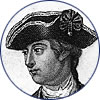David Wooster
1711–1777 B.A. 1738
|

|
The fame of young Nathan Hale has eclipsed that of another Yale hero of the War of American Independence. David Wooster reached a much riper age than Hale, as well as a higher military rank. But other circumstances conspired to rob his death of enduring glory.
On April 26, 1777, a force of about 2,000 British and loyalist colonial troops came ashore at Norwalk, Connecticut. Their mission was to destroy the important supply depot for the Northern Continental Army at Danbury, 23 miles inland. Although the Revolutionary forces and the Connecticut militia mustered several hundred soldiers in pursuit, the raid on Danbury succeeded. The British burned some 40 buildings, including private homes, in which supplies had been hidden for safekeeping, and the loss of foodstuffs, uniforms, boots, and especially 1,600 tents must have hampered American operations in the Northeast.
Major General Wooster, commander-in-chief of the Connecticut militia, personally led an attack on the departing invaders between Ridgebury and Ridgfield, undeterred by cannon fire and the superior enemy numbers. Turning in the saddle to shout encouragement to his troops, Wooster was struck by musket fire that left him paralyzed. He died in Danbury five days later, at the age of 67.
Despite the loss of some 200 men, the British regained their vessels and crossed safely to Long Island. Americans seemed eager to forget the attack on Danbury, and even its chief victim, who had also fought honorably in Canada during the French and Indian War. The monument approved by Congress to honor General Wooster was never built.

